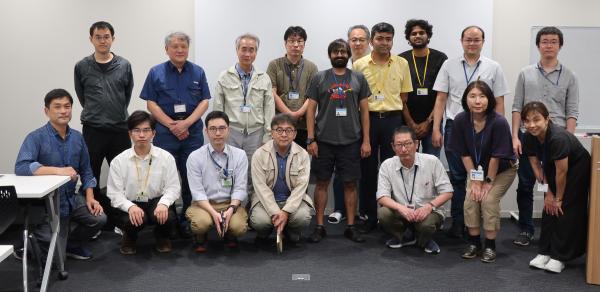2024年10月3日、NIMSにて、Associate Prof. Prasenjit Ghosh(IISER)によるご講演が第162回構材ゼミとして開催されました。
日時:2024年10月3日(木曜日)15:00-16:00
場所:先進構造材料研究棟5階カンファレンスルーム
講演題目:Modelling of Materials: Applications to heterogeneous catalysis and thermoelectrics
講演者:Associate Prof. Prasenjit Ghosh(Indian Institute of Science Education and Research (IISER) Pune, India)https://www.iiserpune.ac.in/research/department/physics/people/faculty/regular-faculty/prasenjit-ghosh/267
開催者:佐原 亮二(計算構造材料グループ)

講演後の集合写真
Associate Prof. Prasenjit Ghosh(2列目右から4番目)
Modelling of Materials: Applications to heterogeneous catalysis and thermoelectrics
First principles density functional theory (DFT) based simulations not only provide a microscopic understanding of material properties but also gives access to information that are often either inaccessible to experiments or are difficult to measure experimentally. Moreover, using the knowledge gained from these calculations one can rationally design novel materials with improved/new functionalities. In my talk I will briefly introduce the application of DFT based simulations to two different areas of material science, namely heterogeneous catalysis and thermoelectrics.
A major concern of the aerospace industry is the facile high temperature oxidation of titanium, which is used in parts of jet engines. The oxide layer formation makes the engine part brittle, thereby resulting in engine failure. Hence, there are tremendous efforts going on to develop oxidation resistant alloys. In an endeavour to understand the effect of alloying and water vapour on the early stages of oxidation of the α-Ti(0001) surface and to identify descriptors for rational design of oxidation-resistant alloys, in this work, we studied oxygen sorption and surface to subsurface diffusion on pure and alloyed α-Ti(0001) surfaces. Our calculations show that the diffusion barrier correlates with the difference in the electronegativity between the alloying element and Ti and the latter can be used as a descriptor for rational design of oxidation resistant Ti alloys. Further, our study of diffusion of hydrogen and oxygen of dissociated water on the pristine Ti surface shows that presence of H in the subsurface facilitates diffusion of oxygen from the surface to subsurface, suggesting that presence of moisture facilitates the oxidation process.
In the second part of my talk I will discuss about applications of DFT based calculations to design materials for thermoelectric applications. Thermoelectric devices are used to convert waste heat to electrical energy. Designing efficient thermoelectric materials are challenging because the electrical and the electronic part of the thermal transport
properties are interdependent and in a reverse way. In our group we focus on understanding the properties of half Heusler alloys for applications as high temperature thermoelectric materials. While these alloys have excellent electrical conductivity and Seebeck coefficient, their performance is poor because of very high thermal conductivity. In this work, we have studied complex half Heusler alloys, where, we have shown that introducing a bonding hierarchy in the material and mass disorders can be effective strategies to reduce the lattice thermal conductivity and thereby improve the thermoelectric performance of the material.